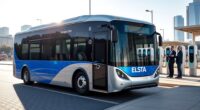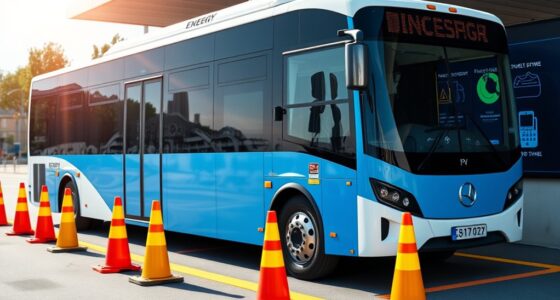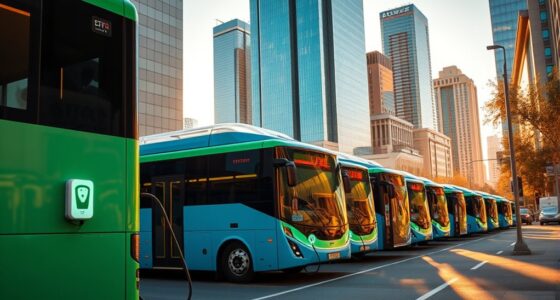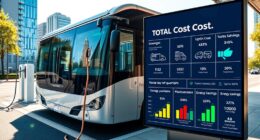By 2025, electric buses represent nearly 4% of the global bus fleet, reflecting a growing shift toward cleaner urban transit solutions. The market is expanding rapidly, driven by advancements in battery tech, infrastructure, and government policies worldwide. Regions like Asia Pacific and Europe are leading the charge, with investments in technology and sustainability. If you want to understand how this shift is shaping urban mobility and what’s fueling this growth, there’s more to discover.
Key Takeaways
- Electric buses are projected to make up nearly 4% of the global bus stock in 2025.
- The market size is expected to reach approximately $187.8 billion by 2032.
- Asia Pacific leads in adoption, driven by China’s policies and market size.
- Europe is experiencing rapid growth due to stringent environmental regulations.
- North America is gradually increasing electric bus fleets supported by government incentives.
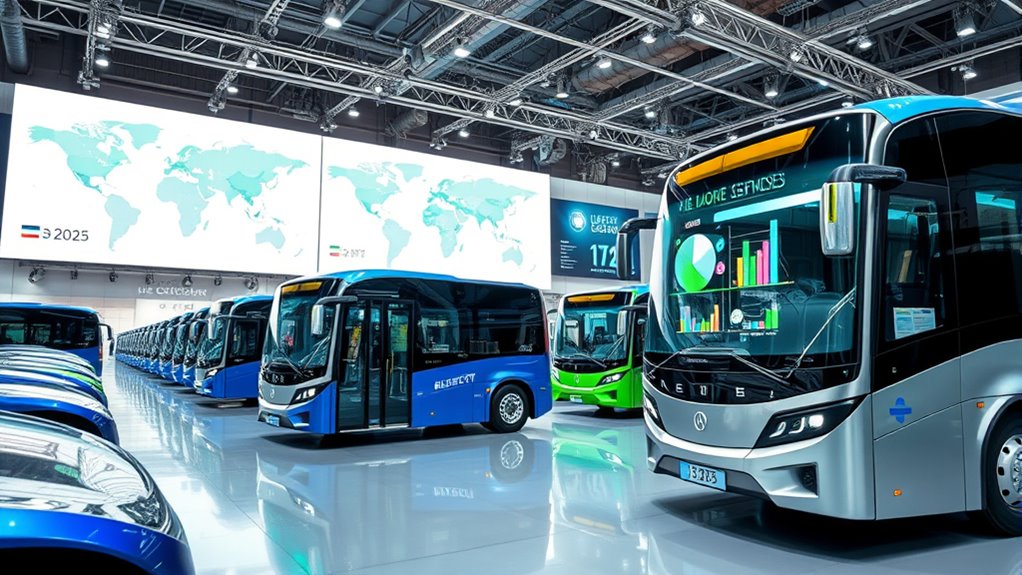
By 2025, electric buses are steadily increasing their share of the global market, driven by stricter emission regulations, technological advances, and government policies promoting zero-emission transportation. This growth reflects a rapid shift toward cleaner public transit solutions, with electric buses becoming a key component of urban mobility.
Electric buses are gaining market share globally due to stricter regulations and technological advances shaping urban mobility.
As you look at the market, you’ll notice that, by this year, electric buses account for nearly 4% of the total bus stock worldwide. While that may seem modest, it signals a notable upward trend from previous years, and the market is poised for even faster expansion through 2032. Experts estimate the market will reach around $187.8 billion, highlighting the high compound annual growth rate (CAGR) expected over the coming years.
Major players like BYD, Yutong, VDL Groep, AB Volvo, and CAF dominate the landscape, continually innovating to improve vehicle performance and cost-efficiency. These companies are investing heavily in battery technology and charging infrastructure, which are essential for expanding electric bus fleets. Additionally, ongoing research and development efforts are focused on reducing battery costs and increasing energy density, further enhancing market competitiveness.
You’ll see that advances in battery technology boost range and efficiency, making electric buses more viable for long routes and daily operations. The development of fast-charging stations allows buses to recharge quickly, minimizing downtime and supporting larger deployments in cities worldwide. Furthermore, these innovations are supported by increasing government incentives that encourage transit agencies to adopt electric vehicles.
These technological improvements, combined with lower operating costs—due to reduced fuel expenses and maintenance—make electric buses increasingly attractive to transit agencies and governments.
Regional trends reveal Asia Pacific as the leader in electric bus adoption, driven largely by China’s massive economies and aggressive policies to electrify public transit. Europe also experiences rapid growth, fueled by strict environmental regulations and a strong commitment to reducing urban pollution.
North America is gradually increasing its electric bus fleets as cities work toward sustainability goals, supported by government subsidies and local initiatives. These regional efforts are further reinforced by international cooperation and agreements, encouraging more cities to set ambitious targets for electrification.
Additionally, the integration of renewable energy sources into charging infrastructure is becoming more prevalent, enhancing the overall sustainability of electric bus operations. The competitive landscape remains concentrated among a few large players, who are constantly pushing technological boundaries to gain market share. As you follow these developments, you’ll notice that the market’s future depends on ongoing innovations in battery technology, charging infrastructure, and the design of more efficient, passenger-friendly buses. Moreover, the increasing adoption of smart grid technologies allows for better management of energy flows and supports large-scale electric bus deployment.
With continued government support and technological progress, electric buses are set to become the norm rather than the exception in urban transportation. Expect their market share to grow steadily, considerably contributing to cleaner, healthier cities in the years ahead.
Frequently Asked Questions
How Will Battery Technology Advancements Affect Market Share?
Advancements in battery technology will markedly boost your electric bus options by increasing driving ranges, reducing charging times, and lowering costs.
You’ll find buses more reliable and efficient, making them more attractive choices for public transit.
As batteries improve with new materials and fast-charging capabilities, you’ll see more operators switching from traditional diesel.
Ultimately, these improvements will help your region adopt cleaner transportation solutions and expand the electric bus market share.
Which Regions Will See the Fastest Growth in Electric Bus Adoption?
Imagine you’re in India, where the government’s FAME incentives already deployed over 10,000 electric buses. You’ll find this region leading the fastest growth, driven by rising demand for public transport, subsidies, and ambitious targets like 50,000 buses by 2030.
Asia-Pacific, especially India and China, will continue to expand rapidly, fueled by urbanization and supportive policies, making it the most dynamic region for electric bus adoption.
What Are the Main Challenges Facing Electric Bus Manufacturers?
You’re facing several key challenges in electric bus manufacturing. High development costs and tech integration complexities demand significant investment.
Infrastructure issues like charging costs, range limitations, and grid capacity strain your operations.
Market hurdles include fluctuating demand, limited government incentives, and stiff competition from established brands.
Regulatory compliance and battery safety concerns also add pressure.
To succeed, you must innovate while managing costs and steering through evolving policies and infrastructure needs.
How Do Electric Buses Compare Cost-Wise to Traditional Buses?
While electric buses offer a compelling future, their initial investment is particularly higher, often around three and a half times that of diesel buses.
You’ll find that subsidies and decreasing battery costs help offset this gap.
Over time, you benefit from lower fuel and maintenance expenses, making electric buses more economical in the long run.
Their environmental advantages and technological innovations further enhance their value, turning initial costs into sustainable savings.
What Policies Are Most Influential in Boosting Electric Bus Markets?
You should know that policies like the EU’s zero-emission mandate, US federal funding, and tariffs on Chinese buses play vital roles in boosting electric bus markets.
These initiatives push manufacturers to innovate, increase demand, and support infrastructure development.
Conclusion
By 2025, you’ll see electric buses painting city streets in vibrant shades of green and blue, their silent engines humming a promise of a cleaner future. As you watch these sleek vehicles glide past, imagine a world where smog fades into crisp, clear air, and urban landscapes shimmer with sustainability. Embrace this shift, knowing you’re witnessing a revolution where technology and nature work hand in hand, shaping brighter, cleaner horizons for everyone.

